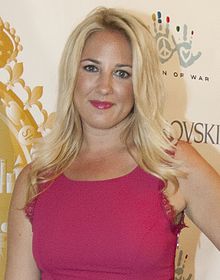Theodora von Griechenland
Prinzessin Theodora von Griechenland und Dänemark (griechisch: Πριγκίπισσα Θεοδώρα της Ελλάδας και Δανίας; * 9. Juni 1983 in London) ist die jüngere Tochter und das vierte Kind des ehemaligen Königs Konstantin II. von Griechenland und dessen Frau Anne-Marie von Dänemark. Sie wurde zehn Jahre nach der Absetzung ihres Vaters und neun Jahre nach der offiziellen Abschaffung der Monarchie in Griechenland geboren.
| Griechische Königsfamilie |
 |
|
Ihre Großeltern väterlicherseits waren König Paul von Griechenland und Friederike von Hannover, ihre Großeltern mütterlicherseits Frederik IX. von Dänemark und Ingrid von Schweden. Zu ihren Paten zählen Kronprinz Alexander von Jugoslawien, Michael I. von Rumänien, Elisabeth II. des Vereinigten Königreichs und Margrethe II. von Dänemark.
Beruf
Theodora lebt seit April 2010 in Los Angeles und arbeitet dort als Schauspielerin unter dem Künstlernamen Theodora Greece. Von 2011 bis 2018 spielte sie in einer wiederkehrenden Gastrolle in der Serie Reich und Schön mit.
Weblinks
- Theodora von Griechenland in der Internet Movie Database (englisch)
| Personendaten | |
|---|---|
| NAME | Theodora von Griechenland |
| ALTERNATIVNAMEN | Theodora von Griechenland und Dänemark; Greece, Theodora (Künstlername) |
| KURZBESCHREIBUNG | jüngere Tochter von Ex-König Konstantin II. von Griechenland |
| GEBURTSDATUM | 9. Juni 1983 |
| GEBURTSORT | London |
Auf dieser Seite verwendete Medien
Autor/Urheber: Alex Black, Lizenz: CC BY 3.0
AcademyOfCoutureArt-LeReveGala-HRH Princess Theodora-Arrivals.jpg
Coat of arms of the Kingdom of Greece in 1936–1973
- Royal Coat of Arms of Greece under the Glücksburg dynasty, created after the restoration of King George II to the throne in 1935, to the exile of King Constantine II in 1967 and finally until the abolition of the monarchy in 1973.
- The Escutcheon features the white cross on a dark blue field of Greece. The Inescutcheon features the Arms of the Greek line of the House of Schleswig-Holstein-Sonderburg-Glücksburg. The shield is then topped with a golden Royal Crown.
- It features an escutcheon divided by the red and white cross of the Order of the Danneborg, the first quarter features the arms of Denmark (three crowned blue lions and nine hearts in yellow field). The second of Schleswig (two blue lions passant in yellow field). The third divided into four; the chief features the three royal crowns in blue field of the Kalmar Union, the second half with a crowned stockfish on red field of Iceland and the last half divided between the ram of the Faroe Islands and a polar bear of Greenland, both on blue fields. The fourth quarter is divided between two halves, the chief depicts a yellow field with a blue lion passant over nine red hearts of the King of the Goths, the lower half depicts a crowned golden lindorm on a red field of the King of the Wends.
- Upon it is another inescutcheon in red, divided into four quarters: the first a a silver nettle leaf of Holstein, the second the a swan with a golden crown of Stormarn, the third a knight dressed in golden armor on a silver horse of Dithmarschen and the fourth of a golden horse's head of Lauenburg.
- Upon it is another inescutcheon divided the first features the red and yellow bars of Oldenburg, the second a golden cross on a blue field of Delmenhorst.
- The escutcheon rests on a golden pedestal and supported by two human figures representing the Greek mythological hero Herakles (Heracles), holding a wooden club and wearing the skin of the Nemean lion.
- The escutcheon is surrounded by the ribbon and cross of the Order of the Redeemer, the cross depicts Christ Pantocrator, surrounded by the order's motto:"Η ΔΕΞΙΑ ΣΟΥ ΧΕΙΡ, ΚΥΡΙΕ, ΔΕΔΟΞΑΣΤΑΙ ΕΝ ΙΣΧΥΙ" or "Thy right hand, O Lord, is become glorious in power" from Exodus, 15:6.
- The motto of the Coat of arms and of the dynasty, depicted on a golden ribbon below the pedestal reads: "Ἰσχύς μου ἡ ἀγάπη τοῦ λαοῦ" or "The people's love, my strength"
- The coat of arms is then surrounded by a dark blue mantle and topped with another royal crown.


